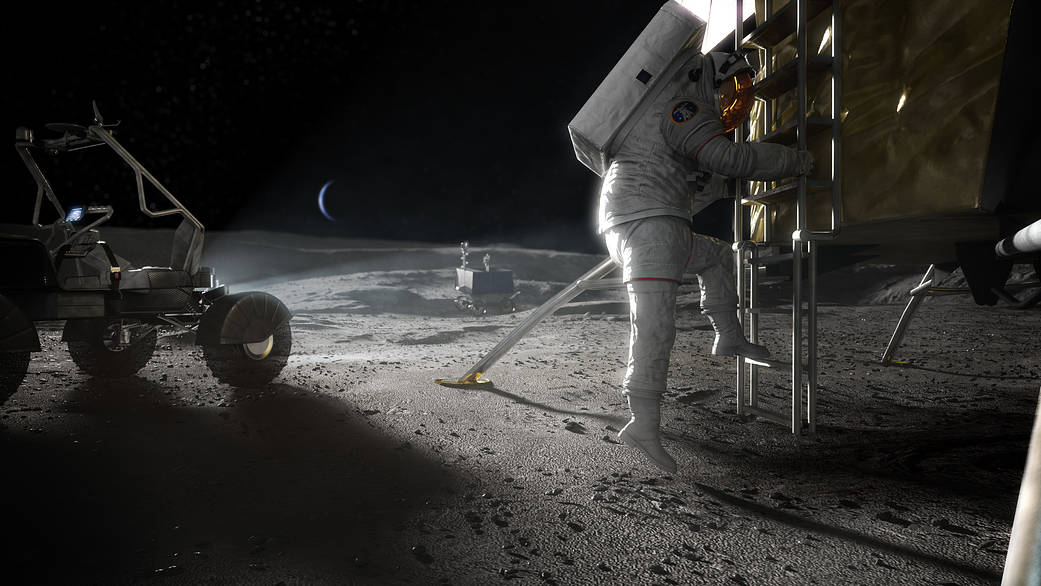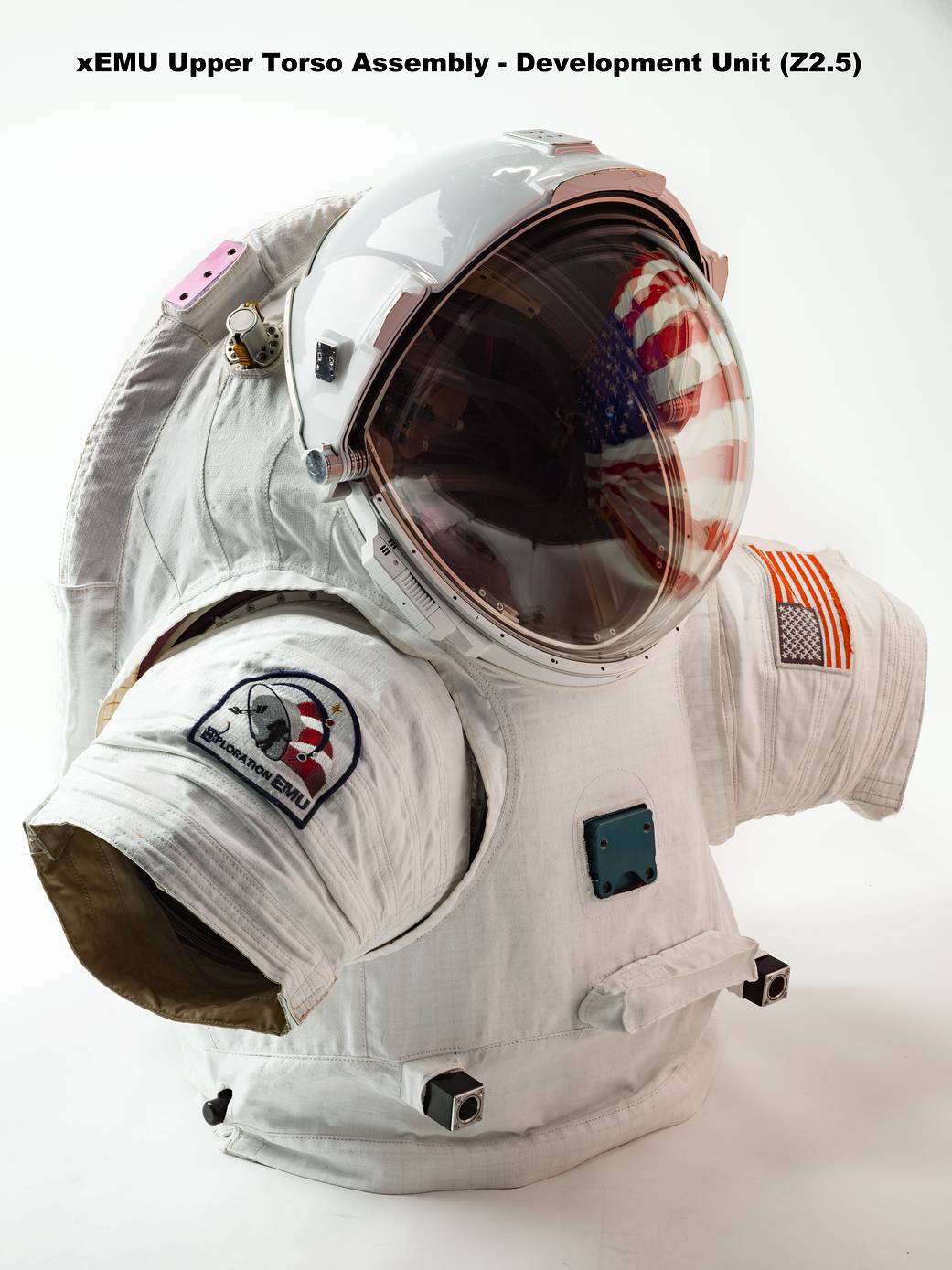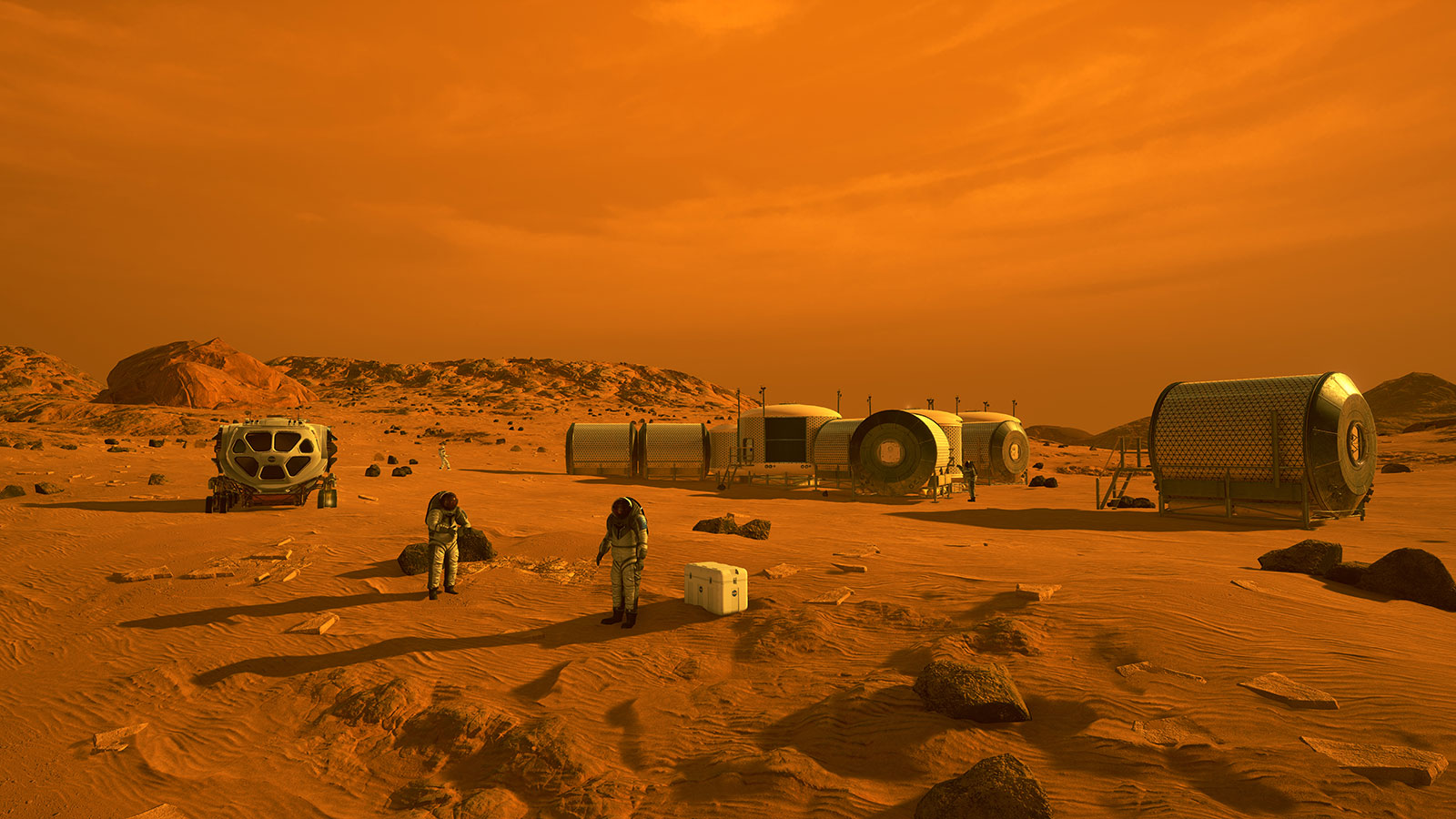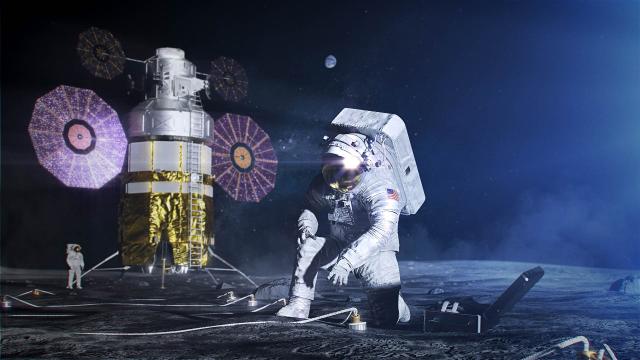NASA is preparing to send a woman and a man to the Moon in 2024, in what will be the first mission to the lunar surface in 52 years. The new spacesuit being designed for the mission is sleek and ultra high-tech, with a swath of features not possible during the Apollo era. Here’s what you need to know about the Artemis spacesuit and how it will take lunar exploration to the next level.
On December 14, 1972, when Apollo 17 astronauts Eugene Cernan and Harrison Schmitt lifted off from the lunar surface, no one in their right minds would have believed it would take a half-century to do it again. But here we are, all these decades later, as NASA prepares for the upcoming Artemis missions to finally return humans to the Moon.

NASA, along with its various partners, are in the midst of developing the requisite technologies to make it happen, including the gigantic SLS rocket, a lunar lander (the Blue Origin-led project seems to be progressing nicely), an unpressurised rover, and instruments to collect and sample water ice, among other space toys. And of course, NASA is also working on its next lunar spacesuit, which it’s calling the Exploration Extravehicular Mobility Unit, or xEMU for short.
NASA recently disclosed the cost of Artemis, saying the project will require $US28 ($40) billion in funding from 2021 to 2025. Of this cost, $US518 ($731) million will be allocated to developing and manufacturing the xEMUs. That’s a hefty price tag, considering NASA has prior experience building suits for the Apollo missions and, more recently, for International Space Station astronauts. And indeed, xEMU is visually similar to the suits worn by astronauts during ISS spacewalks, but that’s basically where the comparison ends.
“The xEMU has been designed from the very beginning to be safer and have fewer catastrophic failure modes than any of its predecessors,” Chris Hansen, the EVA Office manager at NASA’s Johnson Space Centre in Houston, explained in an email. (EVA stands for extravehicular activity, which is NASA-speak for anything done outside of a vehicle, whether that’s in Earth’s orbit or on the surface of another planet.)
Space is a dangerous place at the best of times, but the Moon presents some added challenges.
“Going outside of low-Earth orbit and to the surface of the Moon, the suits will be subjected to higher radiation levels and temperature extremes than our current [ISS] suit,” said Hansen. “The new suits have more complex avionics [electronics] than the Apollo suits, so we have to be very careful to select parts that are radiation hardened and designed to operate in that environment.”
For the Artemis 3 mission (the first to feature a crewed landing), NASA wants to land its astronauts near the lunar south pole. This region is permanently shadowed, so it will present a greater chance that the team will find and collect water ice — a valuable natural resource, not to mention an important object of scientific inquiry. But this spot on the lunar surface is quite frigid — considerably colder than anything Apollo astronauts had to deal with. Accordingly, xEMU is being designed to accommodate these conditions.

xEMU will also need to protect the Artemis astronauts from ionising radiation and non-existent atmospheric pressure. At the same time, the astronauts will still need to explore, set up equipment, and perform science experiments. The suits will also have to endure a full week in these conditions, as that’s how long each mission on the surface is supposed to last.
Accordingly, the suits are being designed to withstand a wide range of temperatures, from -250 degrees Fahrenheit (157 degrees Celsius) in the shade to 250 degrees F (121 degrees C) in full view of the Sun. The suit’s Portable Life Support System (PLSS) will be worn as a backpack, providing power and breathable air, while also removing exhaled carbon dioxide and excessive moisture. PLSS, in addition to regulating the internal temperature and pressure, will constantly monitor the suit for any problems and issue a warning if something seems suspicious. xEMU is being built with plenty of redundancy, like duplicated electronics, to minimise potential problems.
Hansen said he’s particularly excited about two new technologies in the xEMU that have never been incorporated into a suit design before.
“One is our new cooling system called the SWME — we pronounce it ‘swimmy’ — which is the Spacesuit Water Membrane Evaporator,” he said. “The SWME uses water evaporation to cool the suits and their astronauts, rather than the process of sublimating ice, which is used by all previous suit designs. This system is much more robust than current sublimators used on the EMU.”
The second new piece of technology is called “Rapid Amine,” or RCA, which is a new type of carbon dioxide scrubber.
“This system continuously dumps CO2 overboard, so there will never be a limit on EVA duration due to too much CO2 buildup,” Hansen explained. “The current suits have a limited amount of CO2 they can absorb, and this is frequently the limiting factor to how long we can stay outside during an EVA.”

NASA recently launched the SWME to the space station as part of the Spacesuit Evaporation Rejection Flight Experiment, which will test the entire xEMU thermal system over hundreds of hours in the microgravity environment. The RCA technology has already been tested on ISS, but not the miniaturised version built for the xEMU.
There’s also all that lunar dust, called regolith, to consider. A big concern during preparations for Apollo was that astronauts would sink through the soft regolith like quicksand. This turned out to not be the case, but the dusty surface did pose a hazard in the form of tiny, sharp, and corrosive particles. The new suit will be designed to prevent dust from getting inside the suit and from mucking up the suit’s life support systems.
Incredibly, the flexible parts of the suit will be comprised of 16 different layers, as NASA explains:
The layers perform different functions, from keeping oxygen within the spacesuit to protecting from space dust. Closest to the astronaut’s skin, the cooling garment makes up the first three layers. On top of this garment is the bladder layer that is filled with gas to create proper pressure for the body and holds in the oxygen for breathing. The next layer holds the bladder layer to the correct shape around the astronaut’s body. The ripstop liner is a tear-resistant layer. The next several layers are insulation and act like a thermos to help maintain the temperature inside the suit. The white outer layer reflects heat from the sunlight and is made of a fabric that blends three kinds of threads. One thread provides water resistance, another is the material used to make bullet-proof vests, and the third component is fire-resistant. Some suits are plain white and some have stripes to help tell one spacewalker from another.
During the Apollo missions, it was famously a struggle for the astronauts to move, with their restrictive suits making it difficult for them to perform simple tasks, like bending at the knees or grabbing items from the surface. To move around, Apollo astronauts even invented a funny hop, a consequence of low gravity and poor range-of-motion. Those days are over, as xEMU promises for improved flexibility and mobility.

The xEMU pressure garment will consist of an upper torso, lower torso, helmet, and cooling garment. The upper torso connects to two arm assemblies, which together will enable enhanced flexibility, allowing Artemis astronauts to reach across their bodies and move objects above their heads. Special bearings will make it possible for them to make a full rotation of their arm from shoulder to wrist, which will be a considerable improvement over the restrictive shoulder joints of the Apollo suits. With the lower torso, astronauts will be able to bend and rotate at the hips, as well as bend at the knees. The astronauts will enter their suits from the rear.
An interesting note about the cooling garment: It’s made from a spandex-like material and — get this — over 300 feet of woven-in water tubes. These tubes will deliver chilled water throughout the garment, which will be worn on the entire body save for heads, hands, and feet. This will serve to regulate body temperature and prevent astronauts from burning up inside their suits (remember, heat on the surface is as much a threat as excess cold).
Artemis astronauts will also be equipped with hiking-style boots and special gloves that have heaters to keep their fingers toasty warm, while still enabling them to grasp objects.
And now the piece of equipment you’ve all been waiting for: the diaper. Yes, the xEMU features a diaper, because there are no port-o-potties on the lunar surface. Ideally, the astronauts won’t have to use it during their moonwalks, as they can relieve themselves in the lunar lander once they’ve exited their xEMUs. But the diaper, which is made from a combination of commercial technologies, will allow for this possibility should nature call during extended walks, which can last many hours.
[referenced id=”1154179″ url=”https://gizmodo.com.au/2019/03/nasa-all-women-space-walk-is-inevitable-but-sorry-not-the-right-spacesuits-this-time/” thumb=”https://gizmodo.com.au/wp-content/uploads/2019/03/27/mghsi7owyzvplngdtkvg.jpg” title=”NASA: All-Women Space Walk Is ‘Inevitable,’ But Sorry, Not The Right Spacesuits This Time” excerpt=”Astronauts on the International Space Station have completed 214 spacewalks in the past 21 years, but none have been all-women endeavours. So it was very exciting earlier this month when NASA publicised what was supposed to be the first all-female spacewalk in history. But just days before the planned walk,…”]
Excitingly, the new xEMU suit is being designed to accommodate a variety of body shapes and sizes, “which will open the door for significantly smaller people to use the suit effectively,” said Hansen. NASA has learned that it’s “much more difficult to scale a spacesuit down for smaller people than it is to scale it up,” which is why the design team “intentionally designed and tested the smaller suit size first and have collected a lot of great data about its use by smaller individuals, both male and female,” Hansen said. As a consequence, the xEMU “will open the world of spacewalking to a much more diverse population of people, and we’re very excited about that,” he explained.
Another neat thing about the suit is how it can be tailored to match the needs of individual astronauts. At NASA’s Anthropometry and Biomechanics Facility at the Johnson Space Centre, astronauts will undergo full-body 3D scans while simulating anticipated moonwalk movements (no, not that moonwalk, but how cool would it be to see a moonwalk done on the Moon?). With the resulting models, engineers will be able to tweak the suit to provide comfort and a broader range of movement, while minimising potential points of irritation.

The xEMU helmet is pretty much what you’d expect for a 2024 mission. It features an easily replaceable protective visor, which overlays the protective pressurised bubble. This visor can be swapped during the mission should it get scratched, soiled, or otherwise damaged. The helmet also features a protective Sun visor, which, with its special gold coating, will act like a pair of sunglasses, protecting the astronauts from strong rays. Voice-activated microphones will be embedded inside the helmet — no more headsets like the Apollo crew had. This will allow for on-demand two-way communication. The helmet also has a small foam block, which the astronauts can use to scratch an itchy nose. Which, yeah, super good idea — it would totally suck to have to battle an itchy nose you can’t scratch. The xEMU helmet will offer a wide field of view, allowing crew members to see their feet and look up, left, and right.
An important next step in the development of xEMU will be the building of qualification suits. While they’re called “qualification” suits, they’re going to be close match to the real deal, both in terms of specifications and quality-control processes, as Hansen told Gizmodo. He expects to have two qualification suits at some point in mid-2022, once NASA has finalised the mission design. That said, the team is building a Design Verification Test (DVT) suit, which is a kind of “best guess” suit in terms of the final product. Hansen hopes to test the DVT in early 2021. The DVT suit “will be rigorously tested to ensure we are on the correct design path and will be used to better inform our final design,” he said.
Eventually, NASA will want to test the spacesuit on the ISS, which could happen in 2023.
“The modifications to ISS that are needed to support the xEMU are scheduled to be complete in 2022,” explained Hansen. “Once we deliver the suit, we will work with the ISS Program to find the right vehicle to deliver the suit to ISS, which will depend on the very dynamic vehicle traffic to ISS at that time.”
These are tight timelines, so we asked if the covid-19 pandemic is affecting the development of xEMU. Hansen said the design team has been able to work from home, but engineers were in the process of assembling the DVT unit at the Johnson Space Centre in Houston when much of NASA was forced to shut down in March.
“As we developed procedures to safely protect the engineers and technicians working on that suit, we paused that effort for a couple of months,” said Hansen. “Over those two months, we developed those protocols that allowed us to continue that work safely, and work resumed. We are working hard to improve the efficiency of laboratory work, while prioritising the health and safety of our team, and feel like we are back on track.”

A guiding philosophy behind Artemis is that the program will serve as a stepping stone for a crewed mission to Mars, and xEMU is being designed with this in mind. The suit has many elements that will allow for strolls across the Red Planet’s tortured surface. Hansen said that, in addition to being the most mobile planetary suit ever built, xEMU will also be the most autonomous.
“This will be especially important the farther we get away from Earth,” he said. “There are new technologies that will be required, but this suit takes a giant leap forward for the future generation of suits we will need for Mars.”
